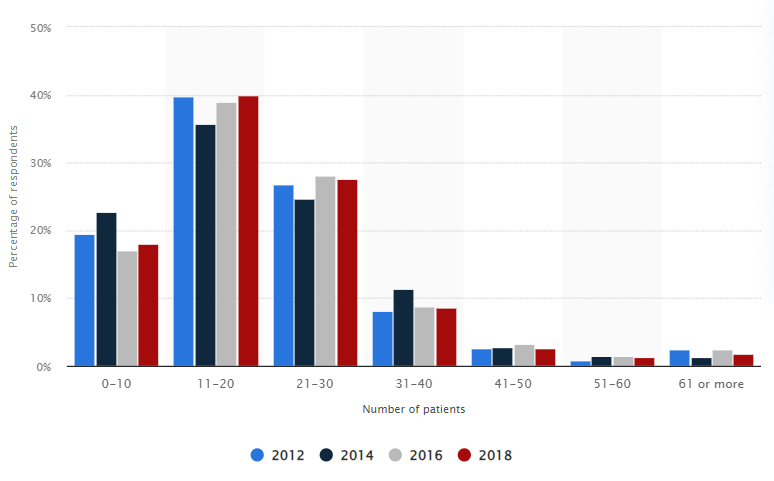In recent years, the popularity of concierge healthcare has surged, with the market expected to grow from $21.1 billion in 2023 to $38.9 billion by 2032. This premium option offers enhanced access and personalized care, catering to patients who prefer a more attentive healthcare experience.
However, as more doctors are going to concierge medicine and more patients explore alternative healthcare models, many find themselves confused when comparing concierge medicine vs direct primary care.
Are they the same, and how do they differ?
Both models promise better doctor access and personalized treatment, yet their structures and benefits vary significantly.
In this blog, we will unravel all about these healthcare models, break down their similarities and differences, provide a detailed comparative analysis, and answer some common questions.
What Does Concierge Medicine and Direct Primary Care Mean?
First things first, let’s briefly define what concierge medicine and direct primary care (DPC) are to set the context.
What is Concierge Medicine?
Concierge medicine, also known as membership-based or retainer-based medicine, is a healthcare model where patients pay an annual or monthly fee for enhanced access to their physician. This model emphasizes personalized care, allowing for more focused and continuous care.
Benefits of concierge medicine:
- Patients have direct, often 24/7 access to their concierge primary care physicians.
- Concierge doctors can spend more time with each patient, tailoring care plans to individual needs.
- May include extended physical exams, preventive care, and coordination with specialists.
Problems with concierge medicine:
- Membership fees can be high, often in addition to regular insurance premiums.
- Some concierge practices may still bill insurance, potentially leading to higher patient costs.
What is Direct Primary Care?
Direct primary care is often confused with traditional healthcare due to its primary care focus, but it operates distinctly.
In DPC, patients pay a flat monthly or annual fee directly to their practice. This model aims to make primary care more accessible and affordable by reducing administrative overhead and focusing on patient-provider relationships.
Pros of DPC:
- Generally lower fees than concierge medicine, making it accessible to a broader range of patients.
- Simplifies the healthcare process by removing insurance companies from the equation.
- Patients benefit from longer visits and more personalized care.
Cons of DPC:
- While DPC covers primary care comprehensively, it may not include the extensive services found in concierge practices.
- Patients might need additional insurance for specialized care or hospitalizations.

Concierge Medicine Vs. Direct Primary Care: Comparison
When comparing DPC vs concierge medicine, it’s essential to understand their similarities and differences. Both models aim to enhance patient care and accessibility, but they do so in distinct ways.
Similarities
Both concierge medicine and DPC share several core features that set them apart from traditional healthcare models. Here are the main similarities:
- Personalized care: Both models emphasize a more personalized approach to healthcare, allowing for longer appointments and a deeper understanding of patient needs.
- Improved access: Patients in both models benefit from better access to their physicians, often with same-day or next-day appointments and the ability to contact their doctors directly.
- Fewer patients: Both models typically have fewer patients per doctor compared to traditional practices, enabling more focused and thorough care.
- Reduced stress for doctors: Physicians in both models often experience less stress due to fewer administrative burdens and a more manageable patient load, which can lead to better patient care.
Differences
Despite their similarities, there are key differences between concierge medicine and DPC that can influence a patient’s choice:
- Cost structure: Concierge medicine typically involves higher fees, reflecting the premium nature of the services provided. DPC aims to be more affordable, with lower monthly or annual fees.
- Insurance billing: How does concierge medicine work with insurance? Concierge practices may still bill insurance for certain services. DPC also bills insurance for certain services.
- Service range: Concierge medicine often includes a broader range of services, such as extended physical exams and in-house diagnostics, whereas DPC focuses primarily on core primary care services.
- Patient panel size: Concierge practices usually have smaller patient panels compared to DPC, allowing for even more personalized attention.
| Features | Concierge Medicine | Direct Primary Care |
| Monthly Fees | Between $250 – $4,500 | Between $25-$100 |
| Patient Panel Size | 400-600 patients | 2,500+ patients |
| Service Range | Offices offer more services and tests | Offices provide a basic level of care |
| Appointment Length | Most doctors spend 30-60 minutes with patients, with about 14% spending 60-90 minutes per visit | Most doctors spend 30-60 minutes with patients |
| Doctor Availability | Doctor is on call 24/7 | Doctor available during business hours |
What Healthcare Model is Right for You?
Choosing between concierge medicine and direct primary care depends on your unique healthcare needs and financial situation. Here are some key elements to consider when selecting the model that fits you best:
Affordability and Cost Structure
- Direct primary care: Ideal if you value affordability and transparent pricing. DPC typically involves lower monthly fees, making it accessible to a broader range of patients.
- Concierge medicine: Best for those who can comfortably afford the higher annual retainer fee. The premium concierge medicine cost reflects the extensive range of services and exclusive care provided.
Access and Availability
- Direct primary care: Suitable if you seek strong patient-doctor relationships with comprehensive primary care services. DPC eliminates insurance hassles, allowing more time for direct patient care.
- Concierge medicine: Preferable if you desire immediate and extended access to your physician. It offers around-the-clock availability and longer appointment times, ensuring your health concerns are thoroughly addressed.
Service Range and Quality
- Direct primary care: Focuses primarily on core primary care services. It’s a good choice if your healthcare needs are straightforward and you prefer simplicity in billing and services.
- Concierge medicine: Offers a broader range of services, including extended physical exams, preventive care, and coordination with specialists. Choose this model if you seek a comprehensive and premium healthcare experience.
Lifestyle and Convenience
- Direct primary care: Suitable for those who want quality primary care without the need for extensive additional services. It’s a great fit for individuals who prioritize cost-effectiveness and direct patient-doctor interactions.
- Concierge medicine: Perfect for busy individuals who value convenience and personalized attention. Services such as house calls and telehealth options can significantly reduce the stress of managing healthcare appointments.
Hybrid Model: Can Concierge Medicine and DPC be Effective Together?
A hybrid model combines the best aspects of both healthcare models, offering premium care of concierge medicine and the cost-effective structure of DPC. This model provides flexibility and improved access, but it’s also crucial to understand its potential drawbacks.
Benefits:
- Enhanced access and personalization: Patients enjoy personalized care, longer appointments, and direct physician communication.
- Flexibility: Offers the convenience of direct payments, avoiding insurance hassles.
- Comprehensive care: A broader range of services compared to standalone DPC practices.
Drawbacks:
- Additional costs: Combining membership fees and direct payments can increase overall costs.
- Insurance exclusion: May require forgoing traditional insurance, posing a risk for extensive or concierge emergency care.
As a leading concierge medical provider, WorldClinic addresses these issues by offering a seamless membership model. Our board-certified physicians provide you with excellent care wherever you are. Our services integrate completely with primary physicians and specialists, ensuring smooth communication and coordination without the hassle of dual payments or insurance complications.
Is the Hybrid Model Right for You?
Deciding whether the hybrid model suits your needs depends on your healthcare priorities and financial situation. If you value enhanced access and personalized care but are concerned about the complexities and potential costs, WorldClinic’s membership model offers a streamlined alternative that mitigates these issues.
Conclusion
Choosing between concierge medicine and DPC ultimately depends on your preferences. Both models offer unique benefits, from personalized care and enhanced access to cost-effective and streamlined services.
At WorldClinic, we offer concierge personalized medicine, concierge family medicine, and executive healthcare services. We actively vet and coordinate with top US primary care physicians, ensuring seamless integration and comprehensive care for our patients.
Ready to experience the best of both worlds with WorldClinic’s premium concierge services?
Contact us today to learn more about our membership plans and how we can support your health and well-being.
Frequently Asked Questions
1. Why is Concierge Medicine Often Confused with Direct Primary Care?
Concierge medicine and direct primary care are often confused because both models prioritize personalized care, longer appointment times, and improved access to physicians.
However, the key difference lies in their payment structures. Concierge medicine involves higher membership fees and may still interact with insurance, whereas DPC eliminates insurance entirely, offering a simpler, more affordable fee structure.
2. What is the Cost Investment of Concierge Medicine vs Direct Primary Care?
Concierge medicine typically involves higher annual fees, ranging from $1,500 to $10,000 per year, reflecting the premium services and around-the-clock access.
Direct primary care, on the other hand, is more affordable, with monthly fees averaging between $50 and $100, making it accessible to a broader range of patients.
3. Can Direct Primary Care Practices Switch to the Concierge Medicine Model?
Yes, direct primary care practices can switch to the concierge medicine model. This transition usually involves introducing higher membership fees and potentially offering a broader range of services, including extended appointment times and more personalized care.
However, such a switch requires careful consideration of the existing patient base and their willingness to adapt to the new model.
4. How Does the Concierge System vs Current Healthcare System Compare?
The concierge system offers significant advantages over the traditional healthcare system, including enhanced access to physicians, personalized care plans, and longer appointment times. Patients benefit from reduced wait times and direct communication with their doctors.
In contrast, the traditional healthcare system often involves shorter visits, longer wait times, and a more fragmented approach to care due to insurance complexities.
5. What are the Statistical Data About What Patients Prefer between Concierge Medicine and Direct Primary Care?
Statistics show a growing preference for personalized healthcare models. The concierge medicine market is projected to grow from $21.1 billion in 2023 to $38.9 billion by 2032, indicating a strong demand for premium, patient-centric care.
While direct primary care is also gaining traction, it’s mainly attracting patients who seek comprehensive primary care without the high costs associated with concierge services.


